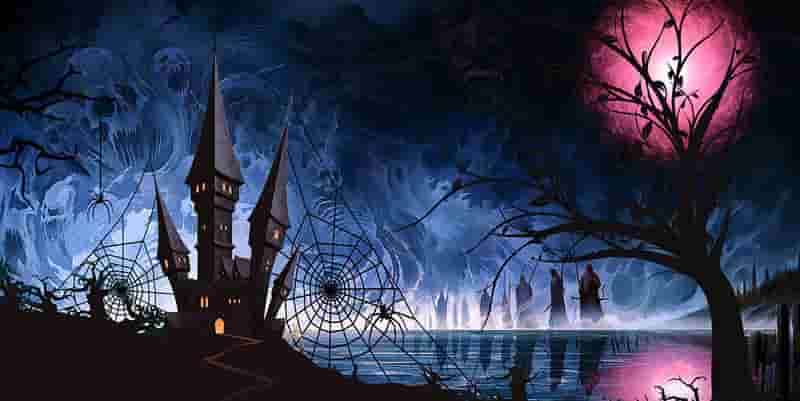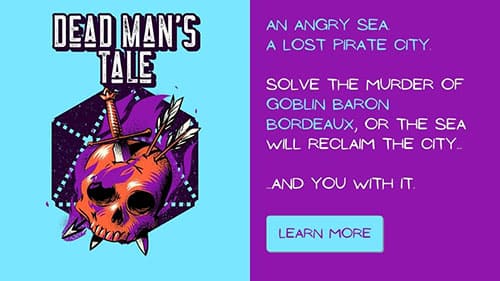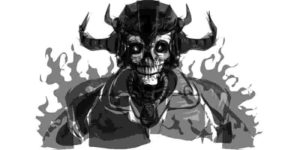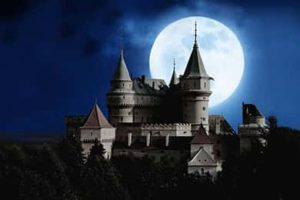Build a haunted campaign with these elements in mind:
- Set up backstory for house and ghosts within.
- Not all ghosts are bad ghosts.
- Mystery themes and clues—keys, letters, paintings
- Haunted cabin, mansion or castle?
- 5e ghosts and haunted house monsters
- Haunted house traps and puzzles.
- Resolve the haunting through the story.
Eerie castles, ghost stories, creepy cabins and gothic settings make for a strong, thematic haunted house adventures in Dungeons and Dragons 5e. As a GM, I can choose a premade haunted adventure like Curse of Strahd or pull from classic ghost stories, motifs and worlds to build my own haunted adventure.
So, what do I need to build a compelling haunted house campaign or one-off?
Set up backstory for house and ghosts within.
Every haunting has a story behind it. Sometimes, spirits are trapped in the house as a sort of purgatory—stuck until somehow released to the afterlife. Other spirits cling to the mortal world out of vengeance and spite, terrorizing those who dare cross the wrong boundary. Most of the time, a tremendous wrong or traumatic event is tied to the spirits’ presence.
This sets us up for an adventure goal. When we know the context of the haunting, we have footing for the characters to investigate. Plus, the backstory adds flavor and atmosphere to the story and gives players other options to resolve the haunting besides typical combat.
A few background prompts to consider are:
- An heiress is murdered for her wealth by a sinister lover and now resides in her old mansion as a banshee or spirit of vengeance.
- A maniacal ghost of a necromancer warlord haunts the ruins of his old fortress, which is full of traps, puzzles and angry spirits.
- Alone in a woodland cabin, a researcher discovers an ancient spell that unlocks an otherworldly presence (Evil Dead).
- The abandoned house on the hill is actually an elaborate wizard contraption built to trap and isolate dangerous spirits (13 Ghosts).
Not all ghosts are bad ghosts.
As empty as a building may seem, it could be crawling with ghosts who just need a little nudge to bring themselves forward. Perhaps an entire family or community of ghosts inhabit a particular building—especially in castles or mansions. Sure, we should include combat encounters with the many spirit monsters of the 5e Monster Manuel.
However, social interactions with ghost NPCs can create opportunities for puzzles, answers and even relationships that push the adventure forward. Therefore, be sure the party knows this before playing. If they attack a friendly ghost on impulse, we could always have the ghost disappear and reappear somewhere else. Maybe crying now because your player is mean.
If you’d like a premade example of this set up, try out my Dead Man’s Tale pirate adventure by clicking here or below.
A few examples of friendly spirits are:
- The ghost of a little girl is trapped in the house by some unknown force.
- A butler spirit inhabits a statue bust of an old lord, animating it to talk.
- The ghost of an old knight is convinced (Charisma check) to possess a suit of armor and take up arms alongside the party.
- A horrific, yet benign banshee cries out in the graveyard before the players enter the house. BEWARE!
- The players unlock a puzzle to release a trapped spirit from an urn—who then reveals an important piece of information to the party.
Mystery themes and clues—keys, letters, paintings
Hauntings are mysterious by nature. If we knew everything there was about the haunting, it wouldn’t be scary. Ghosts carry an inherent sense of mystery. Why are they lingering behind? What do they want with me?
Because of this natural theme, setting up the campaign with mystery elements can bring this sense of wonder alive.
Naturally, the mystery revolves around the backstory of the house. This is the reason the house is haunted in the first place, so solving the problem may release the spirits within. Now, we can include the pieces of this puzzle in the various rooms and settings within the house.
Ability Checks for solving mysteries.
Investigation, History, Religion, Nature and Arcana (Intelligence) checks will help the players piece the mystery together and gain further clues. This means that players can lean on their characters’ Intelligence stat to do some of the heavy lifting. Therefore, we can use these rolls for hints to riddles, puzzles or simply figuring out the next step in the adventure.
Perception, Insight and Survival (Wisdom) checks can be used to pick up hints of danger. Each ability revolves around instinctual senses, which we can play with in a scary setting. Witnessing an eerie occurrence when the other party members are distracted can be used to spooky effect. Plus, Insight is a flexible ability that can be used to sense dishonesty or bad vibes.
Finally, Persuasion, Deception and Intimidation (Charisma) checks can be used to convince spirits to give information. Sometimes, players can even convince an NPC spirit to join the party and help the cause. These checks can come in handy during puzzles inside the house, convincing spirit hosts to give clues to the answer.
Clues
Each clue in the mystery should be like a checkpoint in the dungeon crawl. Each one should be earned in some way. Perhaps the first clue could be found with a successful Investigation check. However, the following clues should be more challenging to receive as the adventure progresses.
When deciding how to piece clues into the mystery, consider the following options:
- Paintings: Paintings can contain hidden messages, important characters and even puzzles that play on themes or words (see Tasha’s Cauldron of Everything Creature Painting Puzzle).
- Journals/Notes: A more personal clue, writings can give the spirits of the house personality as we unravel their living thoughts. Love letters, personal diaries, business correspondence and scientific notes can lead the party to the next chapter of the game.
- Keys: A great way to set up a future obstacle is to present the party with a mysterious key and let them find its purpose. On the other hand, we can introduce unpickable locks to create a puzzle or need for a magic key.
- Murder Weapons: Not necessarily fresh murder weapons—CSI style. However, we can implement an old, buried weapon as a type of treasure that pushes the story forward: an old pistol, ornate dagger or cursed spell book.
- Cryptic Phenomenon: Sometimes, the spirits are unable to talk to the party directly. Therefore, they may use strange events in an attempt to send a message: blood on the walls, doors slamming in important rooms, distant crying or even violent encounters.
Haunted cabin, mansion or castle?
Also, we should consider the size of the haunted house the party explores. This makes a big difference in how the game is played and what options are logically available. Therefore, I’ll take a look at adventures in 3 types of haunted houses—cabins, mansions and castles—and make suggestions for each.
Cabins
Using a cabin in the woods often brings the wild into the haunting phenomenon. Spooky cabins are often the setting of a supernatural force being awakened (Evil Dead, Cabin in the Woods) or just murderous shenanigans (Friday the 13th).
People retreat to cabins to escape society, whether for leisure or nefarious deeds. Here, the players will find secrets. Maybe a strange family moved to the small cabin to escape the evils of the world—only to find an evil within who traps their souls. Or maybe a scholar escaped to the cabin to perform a frowned-upon ritual above his paygrade and accidentally summons something horrible.
Use clues like old journals, haunted dolls and puzzles to jumpstart the action. Maybe solving a particular puzzle in the room unlocks the trapped spirit, causing the party to deal with the evil they’ve unleashed. On the other hand, finding a doll on the floor could summon a ghost child who asks for help. It’s hard to say “no” to kids—even ghost kids.
Plus, we can settings outside the small structure, including eerie cellars and dark forests.
Mansions
When I think of a mansion haunting, my mind turns to gothic romance, wealth and plenty of space for hidden chambers, clues, traps and puzzles. This kind of haunted house is one of the most popular—able to house a spooky exploration and/or a personal story full of mystery.
Maybe the old mansion is empty and abandoned, or maybe a member of the party has been summoned to a special dinner. We can even lean all the way into the trope and reward the party if they spend the entire night.
Related Posts:
Zombie Apocalypse Guide: DnD 5e/RPGs
| Best Grimdark Fantasy Movies and TV
|
Consider these writing prompts when building a haunted mansion adventure:
- One of the party members receives a strange invitation—requesting a party of adventurers to a dinner, which turns into a ghostly murder mystery.
- A nobleman is killed in his home and the party is sent to investigate. However, on arrival, strange occurrences disrupt the original plan.
- The archwizard of a college of wizards has misplaced an important book in his home. Unfortunately, he lives in a mansion built to house and trap dangerous spirits, some of which may have escaped.
- A mysterious mansion appears out of a strange mist near a small village. Adventurers find wonders, treasure and forgotten dangers within.
Castles
The haunted castle makes for a grand, spooky adventure—full of all kinds of puzzles, traps, rooms and unique supernatural monsters. When exploring a haunted castle, we can find settings like dungeons, gardens, open throne rooms, living quarters, armories and spiraling tower staircases.
Though we always have room for a great backstory, haunted castles can be used as a funhouse dungeon adventure. With so much space to explore, and so much variety in setting, we have plenty of opportunity for puzzles, traps and monster encounters.
Consider building out settings for:
- Gardens: Animated trees, ghouls and even fairies could set the mood in a haunted garden. Set the party up for an ambush as if they were exploring a dense forest.
- Dungeons: Naturally, castles will have dungeons—and dungeons are spooky. The grungiest monsters can lurk here: undead minions, zombie and ghouls.
- Throne Room: This is a great place to set up empty suits of armor. Then, when the players confront the final boss fight, the armor comes to life.
- Hallways: Long hallways lit by torchlight can end in abrupt darkness, creating a moment of hesitation as the party investigates. Plus, paintings, extra rooms and statues can help fill the narrow space out.
5e ghosts and haunted house monsters
- Spirits, specters and shades: Naturally, ghostly knights, jesters, wizards and prisoners offer challenging tactics for the party. Possession, invisibility and the frightened condition are common for these encounters.
- Mimics, animated objects: Something about a castle screams mimic opportunity. Of course, chests and doors are all around the castle. Some of them just might bite. Plus, we can’t forget animated suits of armor, swords and statues.
- Vampires, undead: Curse of Strahd style—use vampires as noble class with ghosts throughout the castle. Then, undead thralls and zombies can lurk in the lower dungeons.
- Devils/Demons: I would reserve this level of haunting for a late game boss fight. Perhaps the underlying demon or devil is the cause of the spiritual chaos in the first place—especially in an epic setting like a castle.
Haunted House Traps and Puzzles
Firstly, the haunted should be considered important to the adventure–just as much as the the spirits within. In some ways, the house, mansion or castle is character itself, full of unique environments within a relatively small amount of space. Therefore, adding in elements like traps and puzzles give these haunted environments more obstacles and mystique.
Traps
- Doors: Opening doors in castles and mansions can be dangerous business. Doors can transform into mimics, trigger booby traps contain complex locking mechanisms. Perhaps trying to pick the lock is a bad idea. Plus, castles are great places to hide trap doors in the floor.
- Illusions: Castles and mansions are full of long hallways, which are perfect for setting up illusion traps. This is especially likely in a haunted castle, where apparitions can appear and disappear at will. Mislead players, make them lost and set them up for disaster.
- Hallway of Armor: Playing off the animated armor idea, we could set a locked door at the end of a hallway whose walls are lined with knight armor. A misstep in unlocking the door (trap, puzzle or failed lockpicking attempt) will trigger the spirits within the armor to come to life and attack the party.
Puzzles
- Creature Painting: Introduced in Tasha’s Cauldron of Everything, a painting showing different groupings of monsters hints at a word puzzle. The players must take the number of monsters and count the letters in the monsters’ names. With these letters, we spell out the answer to a riddle.
- Riddle Locks: Every castle needs a good wizard, and wizards tend to hide information in unique ways. One way to uncover important clues is to solve a riddle that opens a magic lock. Of course, the players only have so many guesses before something catastrophic happens.
- Burned letters: Handwritten letters that are “burned” (maybe avoid actual fire), smudged or missing letters creates opportunities for players to piece together missing information. This fits nicely in a mystery campaign as characters collect more clues with the missing info.
- Ghost Memories: Sometimes, benign spirits need help remembering details from their lives. This may be important to moving on. Use riddles to create cyphers—like the Haunted Hallway in Tasha’s Cauldron of Everything. These cyphers can answer a hidden mystery that allows the spirit to move on.
Related Posts:
Guide to Building Pirate Characters: DnD 5e
| Guide to Building a Mystery Campaign: DnD 5e
|
Resolve the haunting through the story.
Finally, resolving this adventure should bring elements of the backstory together in a satisfying way. We don’t just want an adventure based on seek and destroy tactics. Sure, we’ll need a few of those encounters to keep it spicy, but make the story based around something bigger.
Mystery campaigns can be broken down into chapters, where each clue is earned and pieces the puzzle together. Consider ideas such as:
- Components to a magic ritual must be found around the house before the haunting can be resolved.
- Before a spirit of vengeance can move on, the secret to its murder must be revealed. Collect the clues around the house and solve the mystery.
- A secret treasure must be retrieved from the lowest dungeon in the haunted castle to defeat a powerful evil.






